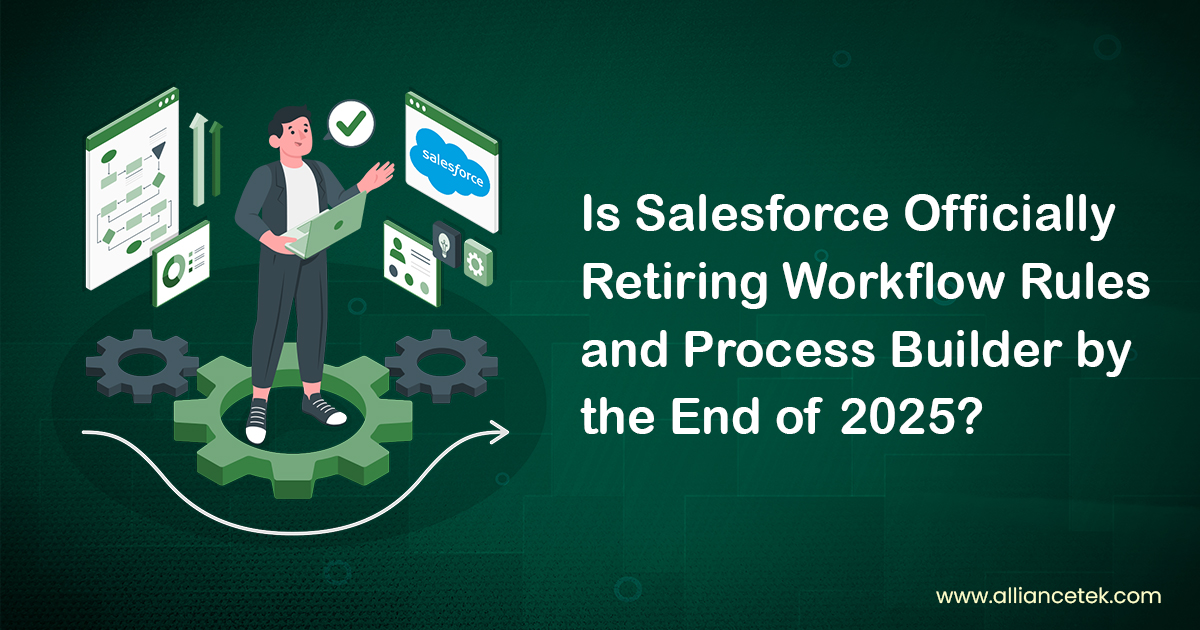Is Salesforce Officially Retiring Workflow Rules and Process Builder by the End of 2025?

If you’ve built your Salesforce automation using Workflow Rules or Process Builder, your setup is about to change. Salesforce has confirmed that both tools are reaching the end of the line. Support is winding down. New automation will no longer be possible in either tool after Spring ’25. And although existing workflows will keep running for a while, they won’t stay reliable.
That puts you in a position where waiting comes with risk. The sooner you move your logic into Flow, the more control you’ll keep over how your systems behave.
This isn’t a small shift. This is a full transition to one automation engine across the platform. You’re replacing two legacy tools with one modern, structured approach that gives you more flexibility, clearer logic, and better long-term stability.
Table of Contents
ToggleWhy Salesforce Is Making This Change?
This decision does not come as a surprise to most Salesforce admins or developers who have been watching the automation strategy evolve over the years. The move is aimed at removing duplication and confusion while creating a consistent experience across the platform.
Here is what brought Salesforce to this point:
- Workflow Rules were the first automation tool, introduced to handle simple if-then business logic.
- Process Builder was introduced later to make automation more visual and layered, but it ended up overlapping with Workflow.
- The presence of two tools created conflict in design choices and deployment planning.
- Flow, which started as a more advanced and technical solution, has now matured to support all use cases previously covered by both tools.
Rather than maintain three separate paths, Salesforce has consolidated everything into Flow to create a single automation engine that is easier to support, easier to manage, and much more powerful in the long run.
The Salesforce automation retirement of the Workflow and Process Builder tools reshapes how business logic is implemented across the platform.
What Happens After Spring ’25?
Starting with the Spring ’25 release, you will no longer be able to create new Workflow Rules or Process Builder flows. This applies across all Salesforce editions. Any automation already created in those tools will continue to run, but the functionality will slowly degrade as new features are introduced only in Flow.
This timeline matters if you are still using the older tools in production:
- No new workflows or process builders can be created after Spring ’25.
- Existing automations will still execute, but won’t be updated for platform changes.
- Over time, stability issues may arise due to a lack of compatibility updates.
If your organization relies on Workflow or Process Builder, now is the time to begin your transition planning. Delaying the move increases the risk of silent failures, inconsistent data, or unsupported logic. This shift marks the end of support for Salesforce Workflow users need to prepare with urgency and planning.
Why Flow Is the Future of Automation in Salesforce?
Flow is not only a replacement but a full redesign of how business logic can work within Salesforce. It gives you tighter control, greater flexibility, and a much clearer structure.
Unlike Workflow and Process Builder, Flow supports:
- Screen-based interactions for building guided processes
- Scheduled triggers and batch logic
- Granular error handling and decision branches
- Reusable components and sub flows
- Connections to external systems through HTTP callouts
The result is a more scalable system that aligns with the demands of modern business automation. These are just a few of the Salesforce Flow Builder benefits that justify the investment in proper migration.
What should you do Right Now?
If your Salesforce instance still uses Workflow Rules or Process Builder, you cannot afford to wait. You need a plan to transition all active automations into Flow.
The best approach starts with a full audit:
- Identify all Workflow Rules currently in use and document their logic
- List every Process Builder automation and break it down into triggers, actions, and dependencies
- Prioritize by business impact to determine which flows must be moved first
- Create a testing plan to validate every migrated automation before switching off the legacy version
Once you know what you’re dealing with, begin your migration using the official Migrate to Flow tool. It will help you convert workflows and processes into flows while preserving logic. However, keep in mind that the tool may not handle every scenario, so manual rewrites could still be necessary. If you’re unsure where to begin, many organizations start with a structured Salesforce Flow migration project plan with more support when they hire Salesforce developers.
Key Differences Between the Tools
Understanding how Workflow, Process Builder, and Flow handle logic differently will help you avoid mistakes during migration.
Here’s a breakdown you can refer to:
| Feature | Workflow Rules | Process Builder | Flow |
| Visual Designer | No | Yes | Yes |
| Multi-Step Logic | No | Yes | Yes |
| Screen Interactions | No | No | Yes |
| HTTP Callouts | No | No | Yes |
| Sub flow Reuse | No | Limited | Yes |
| Scheduled Actions | Yes (basic) | Yes | Yes (advanced) |
| Error Handling | No | Limited | Yes |
The power and versatility of Flow make it the only tool you’ll need going forward. But the shift requires discipline and planning if you want to avoid service interruptions or data issues.
Common Issues You May Encounter During Migration
Moving from Workflow or Process Builder to Flow is not always simple. Many users run into avoidable problems that can delay or derail a clean migration.
Here are some of the most common challenges:
- Unexpected logic loops that break records or create duplicates
- Incomplete testing that fails to catch missing criteria or skipped actions
- Differences in how Flow handles null values compared to the older tools
- Confusion over the right trigger types (record-triggered, schedule-triggered, etc.)
- Overuse of immediate paths when scheduled paths offer better outcomes
To avoid these issues, make sure you review your Flow design with the same rigor you would apply to any development project. Add fault paths, set entry criteria clearly, and always test in a sandbox first. This applies especially when you start to migrate Process Builder to Flow to maintain system integrity and avoid unexpected logic errors. It also helps to hire a dedicated Salesforce developer to take ownership of your Flow initiatives.
Best Practices for Building in Flow
Transitioning into Flow is not just about copying old logic. It’s also your opportunity to rethink how automation should work in your environment. Instead of duplicating bad logic, you should clean up workflows and streamline your process.
Follow these best practices to get the most from Flow:
- Start small and test frequently before deploying to production
- Break large flows into subflows to keep logic organized
- Use record-triggered flows for simple business logic
- Add scheduled paths when delays or follow-ups are needed
- Apply descriptive labels and naming conventions for clarity
- Use fault connectors to avoid silent failures
- Log all decisions or changes where critical data is involved
Treat Flow like a core development tool. That mindset will help you build automation that scales and evolves with your business. Using these standards, Salesforce CRM Development Services teams often redesign automation from scratch to align with new platform expectations rather than simply translate old logic. For best results, consider when to hire remote salesforce developer roles that can work across time zones to accelerate progress.
How to Prioritize Migration Projects?
Not all automations carry the same weight. Some may only update fields, while others trigger emails or write to external systems. If you try to move everything at once, you will stretch your resources and miss key problems.
Here’s how to think about priority:
- Start with high-impact workflows that affect revenue, compliance, or customer experience
- Next, move automations with high usage frequency or dependency
- Then, focus on logic that supports internal processes or operations
- Lastly, clean up legacy workflows that are no longer in use or active
Each batch of migration should include testing, documentation, and user validation. That way, you don’t introduce errors while trying to modernize your stack. When executing this roadmap, it helps to Hire the best Salesforce developers who can analyze business impact and execution complexity together.
Tools and Resources That Can Help
Salesforce has provided a few helpful resources to assist with your transition. While you should not rely entirely on automation tools, they can reduce manual effort for straightforward logic.
Consider using:
- Migrate to the Flow tool for Workflow and Process Builder conversions
- Flow templates from AppExchange for common use cases
- Debug logs and Flow error emails to monitor issues during testing
- Flow Builder tutorials and help documentation to improve your design skills
- Custom components created through Salesforce Application Development Services for screen-based interactions
Use these tools to support your migration, but always verify the outcome. No tool can replace good judgment and thorough testing. Many of these tools are also part of broader Salesforce process automation tool ecosystems that continue to evolve alongside the platform. When execution needs to accelerate, many companies choose to hire top Salesforce developers who’ve completed similar migrations in enterprise environments.
Why You Should Not Wait Until the Deadline?
The Spring ’25 cutoff may seem far off, but complex environments often take months to untangle. Migration also requires buy-in from stakeholders, scheduling with admins, and time for testing and approvals.
Waiting until the last minute means:
- Your team will rush through migration without understanding key differences
- You may miss bugs that affect your live environment
- You will be forced to deploy untested flows to avoid outages
- You will have no fallback when the legacy automations stop working
Instead, give yourself room to migrate thoughtfully. Even moving a few flows each month will put you ahead of the deadline. If you’re working with a Salesforce Consulting Services partner, they will likely advise immediate action for exactly this reason. They may also recommend you hire expert Salesforce developers to lead parallel workstreams where critical automations exist.
What You Should Communicate to Stakeholders?
You may need support from executives, managers, or team leaders to get time and resources for the migration effort. Don’t just tell them Flow is new. Explain what will happen if you don’t move fast enough.
Make sure stakeholders understand:
- Existing automations are running on unsupported tools
- FutureSalesforce Developers’ Features will not work with Workflow or Process Builder
- Delaying migration increases support costs and technical debt
- Migrating early reduces risk, improves performance, and simplifies audits
Framing the migration as a risk-reduction effort can help you get the approvals you need. It also helps build internal support when disruptions arise during the transition. The safest approach? Hire certified Salesforce developers to guarantee compliant, scalable design patterns from the outset.
Long-Term Benefits of Moving to Flow
Once your transition is complete, you will have a single platform for all business logic. This makes automation easier to manage, easier to troubleshoot, and easier to scale.
You will see long-term value in several areas:
- Fewer errors due to consistent design standards
- Easier onboarding for new admins and developers
- Better alignment with Salesforce’s platform evolution
- Greater flexibility for building custom business logic
- Stronger integration options for external systems
By centralizing your automation into Flow, you gain clarity and control over your entire Salesforce system. That sets the stage for growth, compliance, and performance. This is why many teams partner with Salesforce CRM Development Solutions experts to redesign and implement automation from the ground up. When stakes are high, it becomes essential to hire Salesforce consultants who can guide executive stakeholders and technical teams alike.
Using the Right Services to Support the Shift
If your in-house team lacks the bandwidth or technical expertise to handle this transition alone, consider working with firms that offer end-to-end support. You need more than just development help; you need a partner that understands automation strategy and long-term design.
Look for firms that offer:
- Strategic planning and logic mapping
- Technical migration of automation into Flow
- Documentation of business rules
- Testing and QA for every flow
- Post-migration support and adjustments
These firms often include Salesforce Customization Services as part of the engagement, helping you align every flow with real business needs.
Final Thoughts
The end of support for Workflow Rules and Process Builder is not optional. The only question is how prepared you are to make the shift. You now have one path forward, and that path is Flow. By planning, using the right tools, and taking a structured approach, you can complete your migration without surprises.
You will not just be reacting to a deadline but building a more future-ready Salesforce org. For more information about Salesforce’s new updates, contact the dedicated developers at AllianceTek.
Author Bio: AllianceTek has more than 18+ years of experience providing end-to-end software engineering services, with extensive experience in building Mobile, Cloud, and Web solutions. Our core expertise lies in building solutions based on leading technologies and platforms, such as Microsoft .NET, Salesforce, Microsoft SharePoint, Azure, Amazon Web Services, iOS, Android, and many others.
https://gravatar.com/alliancetekinc
Lareal Young is a legal professional committed to making the law more accessible to the public. With deep knowledge of legislation and legal systems, she provides clear, insightful commentary on legal developments and public rights, helping individuals understand and navigate the complexities of everyday legal matters.
Recommended For You
Spread the loveThe world of healthcare administration can feel like a maze, especially when you’re navigating programs like the California
Spread the loveIn the intricate world of digital content creation, achieving consistent and accurate color representation across various platforms, devices,
Spread the loveArtificial intelligence is no longer a concept on the fringe of productivity. You now have tools that learn
Browse by Category
- Travel
- Technology & Gadgets
- Sports & Games
- Software
- Shopping
- Reviews
- Real Estate
- Numerology
- News
- Make Money
- Lifestyle
- Law
- Home Improvement
- Health
- Gardening
- Games
- Finance
- Entertainment
- Education
- Digital Marketing
- Diet and Fitness
- Dating
- Construction
- Celebrity
- Career and Jobs
- Business
- blog
- Angel Number




